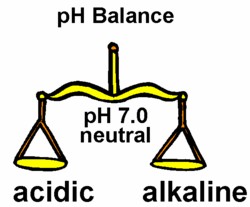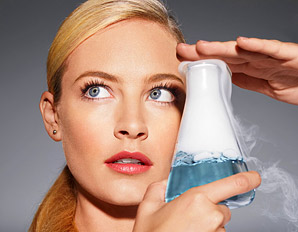You’ve probably noticed that some skincare products define themselves as “pH balanced”. Maybe you’ve tried to remember your high school chemistry lessons in order to figure out what that means. When it comes to having healthy skin maintaining a proper pH level is important.
What Is pH?
Let’s refresh your memory about what the pH scale is anyhow:
Simplistically, it’s nothing more than a measuring system for comparing the strength of acids and bases. An abbreviation for “potential of hydrogen”, chemists long ago realized molecules which give up more protons the positively charged portion of an atom when placed into water, differed from those that give up a hydroxy group (OH-).
A scale from 1 to 14 was created to gauge these properties. Water, the elixir of life, is neutral; it is neither acidic nor alkaline. It was assigned the midway point on the scale: 7. Anything below 7 is categorized as an acid; those above, a base. ( Note: the terms base, basic and alkaline all refer to the same thing. ) The further the pH shifts from 7 in either direction, the stronger (and potentially irritating) the solution. So a compound with a pH of 3 is more acidic than one at 5; a base at 8 is less potentially irritating than one at 10.
Source: pH and Your Skin by Audrey Kunin, M.D. on DERMAdoctor.com
pH and Your Skin
Our skin’s pH is affected by the skincare products that we use, our environment, our age, and lastly our diet. When the skin’s acid mantle, a thin layer of sweat and sebum that sits on the epidermis and protects our skin, is disrupted by products or factors that are either too acidic or too alkaline skin issues occur.
An imperceptible thin viscous fluid, the acid mantle, important for maintaining overall health of skin and hair, protects both skin and hair. Secretions formed by sebaceous and eccrine sweat glands comprise the acid mantle. Sebum (the oily substance produced by the sebaceous glands) and sweat, (the salty, watery mix produced by the eccrine glands) blend and are further acidified by secretions from normal flora of the skin (bacteria known as Staphylococcus epidermis). The normal acid mantle for both skin and hair ranges between 4.0 and 5.5.
Sunlight, diet, excessive sweating and the application of skin or hair products can all lead to disruptions in the acid mantle.
The epidermis is protected by an external layer of dead, dry, tightly knit cells (outer stratum corneum) arranged like shingles on a roof. Any disruption to the acid mantle, elevating overall skin pH, interferes with this protective barrier, wrenching cells away from each other and results in dehydration, roughness, irritation and noticeable flaking. Skin is left defenseless and susceptible to further environmental damage.
As cells pull apart, minute breaks become exposed, leaving skin more vulnerable to bacterial invasion. Under normal circumstances, bacteria not only have a difficult time penetrating through the stratum corneum, but the acid mantle creates a hostile environment for bacteria which prefer an alkaline environment to flourish. A rise in pH plays mayhem with natural infection prevention, further increasing infection due to bacteria typically paralyzed by an acidic environment. Once the pH exceeds 6.5, bacterial invasion increases dramatically, a loss of normal skin integrity results and a variety of various skin diseases and disorders such as atopic dermatitis, seborrhea, ichthyosis and irritant contact dermatitis flare.
Source: pH and Your Skin by Audrey Kunin, M.D. on DERMAdoctor.com
You can damage the acid mantle and throw off your skin’s natural pH balance by using skincare products that are too acidic (think glycolic acids and other AHA acids) or too alkaline (harsh detergent soaps, like typical bar soaps). Skin whose pH level has been disrupted can feel dry, irritated, and look dull.
Maintaining a proper skin pH isn’t too hard. In order to restore balance to your skin choose a gentle or creamy cleanser, moisturize often, don’t spend too long in the shower, and protect your skin from the sun.
Source:
-
The Right pH for Perfect Skin – New Beauty Fall-Winter 2009
Further Reading:
- How to Check the pH of Your Cosmetics – The Beauty Brains
- Why is pH Important? – The Beauty Brains
- How pH Affects the Formulation of a Product – Skin Inc.
Image from allaboutparasites.com











Recent Comments